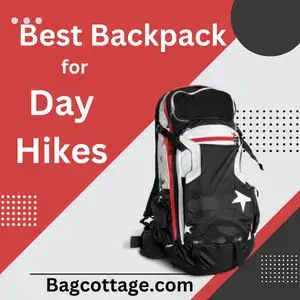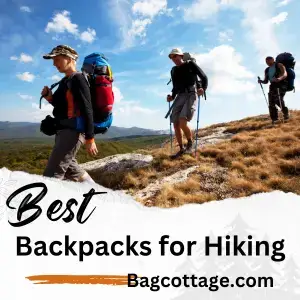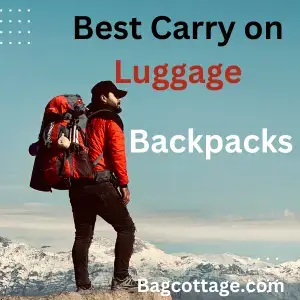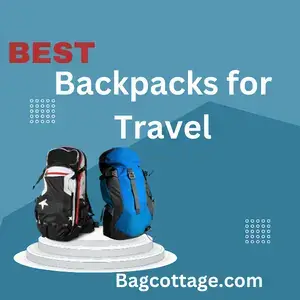10 Best Backpacks for Backpacking and Traveling of 2024
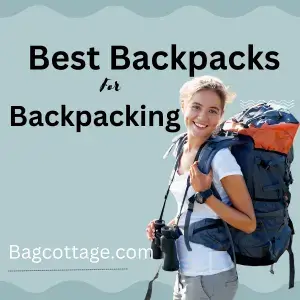
Finding the best backpacks for backpacking can feel like an impossible task. We’ve spent over two years testing 55 different groups on trails worldwide, including in some pretty inhospitable places.
Our wilderness experts are constantly watching these guides because they’re serious about helping you find products that will work for your needs – no matter how tough or light weighty those might be (or both.).
We want our readers to get their money’s worth when purchasing gear, so each entry includes detailed information about what makes it stand apart from competitors; this way, there won’t be any problems they will face with time.
Table of Content
- Best Backpacks For Backpacking | Our Top 10 Picks
- 1. Osprey Atmos AG 65 Men’s Backpacking Backpack
- 2. Gregory Mountain Products Women’s Deva 60 Backpacking Pack
- 3. Osprey Exos 58 Men’s Backpacking Backpack
- 4. Osprey Atmos AG 50 Men’s Backpacking Backpack
- 5. Kelty Coyote 60-105 Liter Backpack
- 6. Gregory Mountain Products Men’s Baltoro 65 Backpacking Pack
- 7. Osprey Rook 65 Men’s Backpacking Backpack
- 8. Osprey Aether 65 Men’s Backpacking Backpack
- 9. Granite Gear Crown 2 60 Backpack
- 10. The North Face Terra 55 L Backpacking
- Features In Consideration For The Best Backpacks For Backpacking
- What Are The Focus Points For Selecting the Backpack?
- A Brief Overview Of Backpacks
- Back Parts Of The Backpack
- Front Features
- FAQs
Best Backpacks For Backpacking | Our Top 10 Picks
Now you can check one by one all the top 10 Best bags for backpacking.
1. Osprey Atmos AG 65 Men’s Backpacking Backpack
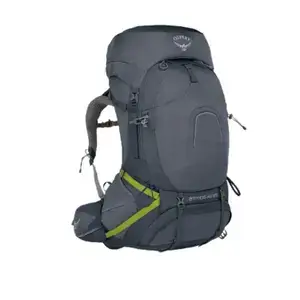
We love the comfort and design offered by Osprey’s 65L Atmos AG and consider it one of the best for all-around backpacking. This pack is loaded with features, including incredible ventilation, so it’s not surprising that it has a cult-like following.
The bag offers excellent padding and ergonomic support and allows for maximum airflow to prevent overheating. If we had to pick just one feature that makes this stand out from other similar packs, It would be Osprey’s innovative anti-gravity suspension feature that helps spread weight more evenly without the feeling of carrying excess baggage around your hips or shoulders.
Perhaps it’s because I’m getting older and more jaded, but while testing the Osprey Atmos AG 60 (and just backpacking in general), I couldn’t help but feel that the pack itself was a bit overkill.
A 30-liter daypack will feel huge to most men in their 20s, but for all of us over-forties, this feels like way too much space, and at 4.5 lbs., it feels heavier than some of the loaded-down expedition packs my friends have lugged around recently.
There is no disputing that this big discounter offers excellent ergonomics, breathable shoulder straps, plus loads of extra options for staying organized on your travels.
Furthermore, if you plan to haul more than 45 pounds every day frequently, it’s good to go with a different model – this pack isn’t as good at handling heavyweights. Also, while most reviewers enjoy using the Atmos 65 AG, some testers felt stuck in a hug too tight while carrying the pack around when trying to adjust clothing layers or put on additional gear.
2. Gregory Mountain Products Women’s Deva 60 Backpacking Pack
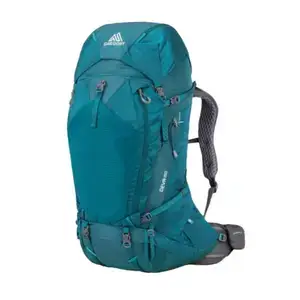
Gregory’s Deva 60 is a lightweight backpack for traveling light when trekking out in the backcountry. It makes for an excellent backpack on a multi-day hike from camp and a day pack since they can be detached from one another using a zipper system. This is also suitable for a backpack for hiking.
Has enhanced ventilation, so you don’t get too hot while hiking, and an I-beam spine to make it sturdy during your travels that range in elevation or through rugged terrain or to help with balance when climbing up or down rocky outcrops. All the features help in the Best Backpacking Backpacks for Women.
Comfort is essential for every hiker and backpacker and comes with several factors. If you have a specific body type (like narrow-shouldered women, for example), looking for the best backpacks that match your physique might be challenging when considering all the options out there. Maybe it is time to look at switchback hiking packs instead. More specifically, those from Osprey like the Deva 72. Let’s take a look at its features.
3. Osprey Exos 58 Men’s Backpacking Backpack

The Osprey Exos 58 is one of the best lightweight options we tested. At 2.6 kg (5.73 pounds), it was among the lightest backpacking packs in our review, making it close to several frameless backpacks and only slightly heavier than some of the more minimalistic models we tested.
When used at 30 pounds or below, this pack felt comfortable and supportive, more like some of its much heavier competitors we reviewed, like the Gregory Baltoro 65. However, when carrying 35 pounds, it didn’t feel as lovely or supported as other lighter models like the Marmot Kompressor 18.
Backpacking these days has become popular among many people trying to escape from the chaotic lifestyle that modern life often entails.
For those seeking a lighter, more comfortable alternative to sleeping in hotel rooms and eating out, backpacking can be ideal for spending one or more nights out in nature. However, even if it’s not your first time venturing outside the urban city limits, there are many essential features you need to take into account when purchasing a pack – like durability, lightweight design elements, and comfort.
Your sleep system should be light and comfortable, but not so much that it sacrifices durability for ease of use. In addition, the great frame construction is necessary for overall comfort when traveling with heavy loads over multiple days.
The Exos backpack has many aspects that make it a practical choice for everyday use. One of our testers’ favorite features was the stretchy mesh beavertail pocket on the back.
The pouch is entirely secure, and we found quite a few uses for it, from storing small items that you wish to keep easily accessible to keeping smelly clothing or garbage away from the rest of your things which turned out to be quite valuable. It was also great for unusually shaped items like flip-flops or a frying pan.
4. Osprey Atmos AG 50 Men’s Backpacking Backpack
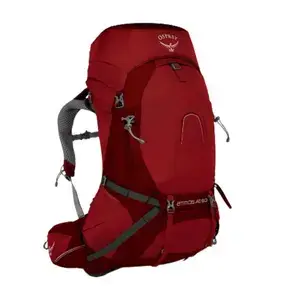
The main compartment is designed to be large and spacious. This compartment features padded 3D suspension contouring that syncs with your body’s natural curves by creating a plush area between the suspended foam and your pack’s frame, which feels nearly as comfortable as a soft pillow.
There are also upper and lower side compression straps that provide about 20″ of adjustability to give you a more custom fit for better weight distribution and carrying comfort.
The ventilation system works by using an anti-gravity ventilated mesh back panel. This helps to reduce any pressure points that cause discomfort and allows the weight of your load to spread out evenly across the back panel, providing a superior fit and making it easier for you to hike longer distances even when carrying heavier loads.
This pack has two pockets on the top and a safety whistle and is a sleeping bag compartment under the backpack that can be removed easily. It has some nice tool loops and dual access stretch mesh side pockets with InsideOut compression straps.
The pack exterior also features a front stretch mesh pocket that you can store your tools into it, 2 zippered hip belt pockets, and a Stow-on-the-Go trekking pole attachment on the bottom of the backpack.
5. Kelty Coyote 60-105 Liter Backpack
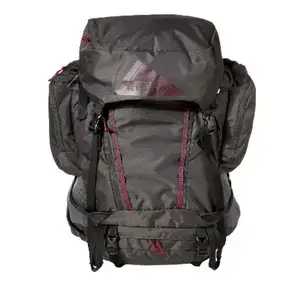
Built for those who have to take long excursions into the wilderness, the GORUCK rucksack can handle any place you might find yourself on your journey.
Its cavernous main pocket provides plenty of space for anything you might need during your trip, including a separate compartment for a sleeping bag and slots for water bottles.
Thanks to its internal perimeter frame, the many thoughtful details make this smaller pack feel spacious and comfortable both around town and on an extended trip, which keeps the weight stable on your back even when fully packed.
The bag can stand up to whatever abuses you throw its way, thanks to the rugged construction designed by GORUCK. Overall, it’s a highly versatile backpack but the best women’s backpack for backpacking that can handle pretty much anything you might need it for. This is known for being the best large backpack for backpacking.
This backpack lets your back breathe on those hot days, so no more sweaty back. It has a capacity of 65 liters, which is more than enough for whatever you need to get through the day.
This backpack won’t let you down. It’s made for people who are looking for a backpack that isn’t too big and isn’t too small but falls right in the sweet spot.
It looks great while doing it. All in all, I would recommend this backpack to anyone looking to start adventure travel or perhaps just need an everyday alternative to carrying a briefcase or purse around.
6. Gregory Mountain Products Men’s Baltoro 65 Backpacking Pack
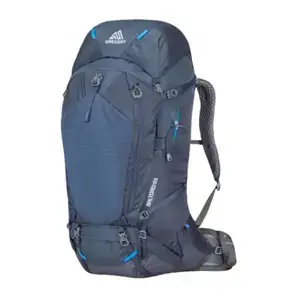
Gregory’s Baltoro 65 is one of the most comfortable backpacks we’ve ever worn. This pack is right up there with the best when it comes to loading-hauling ability.
We tested loads that may have been heavy for other models, but not this one. It was hardly noticeable even when carrying heavier loads of 40 pounds or more, and the Gregory felt like it could handle even more than our max weight test.
There are a few packs we’d rather haul with a great big load than this one. The Baltoro has padding and cushioning that makes you feel like you’re floating in the air while wearing it – and can carry heavy loads without any breakage or hindrances whatsoever.
Our testers said that the Baltoro 65 is one of their favorite packs because of its exciting styling, solid suspension, and comfortable fabrics, but it has drawbacks.
The frame can be challenging to pack because the bag is relatively narrow at rib-cage level. Because of this, loading during trips where moisture and mud may be an issue makes us wish for a more rugged and waterproof fabric on the inside of the straps that contact your shoulders. Instead, we find ourselves seeing mesh for anything but light clothing.
7. Osprey Rook 65 Men’s Backpacking Backpack
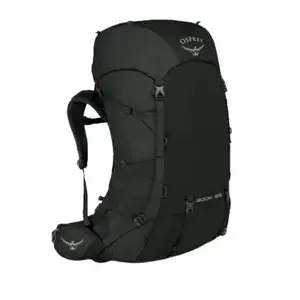
The Osprey Rook 65 is an essential pack and the best budget backpack for backpacking that could be good for carrying smaller loads up to around 40 pounds.
This travel backpack isn’t the best choice for wilderness backpacking because it isn’t designed to fit larger volumes of gear and other essentials you might need on a long adventure trip.
It has full access, a water bottle pocket, and an adjustable hip belt – these are characteristics we look for in a daypack like this one. However, according to consumers in our research, its shoulder straps lack any padding, and its frame and bottom; lead us to believe that the Rook 65 would not be very comfortable or supportive for longer excursions away from home.
The Osprey Rook 65 scores in the lower tiers with a mediocre overall performance combined with a lackluster but straightforward set of features. Its suspension system, located in the back, offers some good stability for carrying more weight making it the best backpack for backpacking; however, users report feeling loads more comfortable with this pack than other models.
One attribute that users felt lacked in the features department was its stiffness which users reported as a little bloated and underwhelming while merely adequate when comparing this model’s performance to similar packs with similar prices.
The Rook 65’s lower weight is an advantage; however, when compared to competitor products, it doesn’t stand out nearly as much as one might have originally thought. Overall, we feel better options are available for individuals who typically carry lighter loads.
8. Osprey Aether 65 Men’s Backpacking Backpack
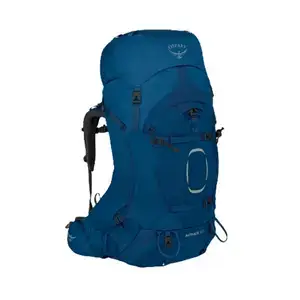
The Torso can be adjusted to fit on the fly. It is important to get a custom fit to feel nice and comfortable against you as you run. This way, they will be able to make the most of their time and focus on other, more important tasks.
The shoulder straps keep the pack close to your body. This helps contour to your particular frame, which makes them more efficient when it comes down to running.
They are padded based on needs in some cases, or they can accommodate different shapes and sizes of runners based on need. Plus, if any changes are needed going forward, everything can be adjusted accordingly without causing any problems, with all sorts of people enjoying the same experience that much more efficiently because it fits them better aside from how it’s being worn itself. Every person has their own way of choosing the best backpacks for backpacking.
The front shove-it pocket of this product can hold rain gear or pack in materials. The dual-access stretch mesh pockets on the side of this pack are convenient for securing water bottles without restricting reach for other gear.
You can store climbing gear and extra tools needed during hikes with the dual ice ax loops with bungee tie-offs along the side of this product.
9. Granite Gear Crown 2 60 Backpack
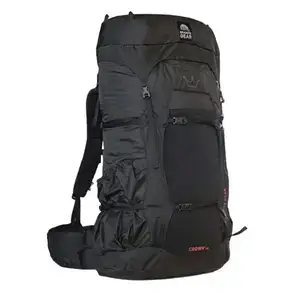
UOG TOP PICK – Granite Gear Crown 2 Pack – At only 2.2 lbs, this ultralight backpack for backpacking can handle up to 35 lbs comfortably.
Our favorite features that we always look for in a lightweight pack are an innovative Vapour Current Mark 2 compression molded PP frame sheet with a molded foam back panel and a bonus lid (removable).
It also boasts our patent-pending fully adjustable Re-Fit hip belt that is so secure that once zipped into place, it stays there even when carrying large loads over rough terrain.
The successor to Granite Gear’s Crown VC 60 is one of our all-time favorite packs. The new Crown 2 model keeps all the good points that made its predecessor an excellent choice for long-distance hikers and adds several other improvements, including two hip belt pockets, which many people find very useful.
By adding a relatively small amount of weight, this new model also includes some excellent features that backpackers would be excited about because they make our lives easier. At the same time, hiking, such as a mesh back panel that helps keep us cool and a security pocket located on the bottom straps of the pack.
10. The North Face Terra 55 L Backpacking
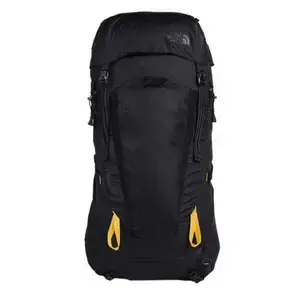
The Terra 65 is a fantastic mid-range pack for anyone looking for a new backcountry option without breaking the bank at just over two hundred dollars.
This pack offers the best backpacks for backpacking and enough storage capacity (65 L) to pack in everything you need and more but is still fairly lightweight at only 28 oz, making it easy to carry on multi-day hikes or spontaneous weekend trips.
Although this bag isn’t super spacious, it can still fit your gear if you are going away overnight with the essentials or even as a carry-on shoulder bag while traveling so that you don’t need to take as much out of your main luggage just to survive a few days on the road.
The materials used in this backpack are also quite sturdy and waterproof, which provides great durability whether you’re hiking through difficult terrains or carrying heavy textbooks from class to class all day. The Terra 65 from Osprey is an excellent choice for those who want a quality backpack but don’t want to break the bank.
This pack is for students who enjoy nature and the outdoors but need a laboratory inside their backpack and it is among the cheap backpack for backpacking. It’s very affordable, waterproof, and great at giving you space to store books, laptops, tablets, or anything electrical and technological with you through your hikes.
Features In Consideration For The Best Backpacks For Backpacking
While there are many things to consider when planning a backpacking trip, one of the most important factors is what kind of bag you’ll need.
There’s no point in going on an adventure if your equipment doesn’t work well, so picking up some best backpacks for backpacking is the only solution.
One helpful hint: don’t forget about moisture-wicking fabric clotheslining or fabric protection for sensitive areas at night because linen gets sweaty after long periods of use. This passage discusses how selecting proper gear can ensure comfort during extended walks.
There are some other types of backpacks for day hikes. You can just click on the link and choose your choice.
What Are The Focus Points For Selecting the Backpack?
Traveling Distance And Destination
Whether you’re on a two-month trek or just taking the helm for an upcoming holiday, it’s important to plan and ensure your belongings don’t end up in unwanted hands.
The amount of time away will determine how much gear needs packing while space is still available inside vehicles and outside ones. You can’t just plan to pack light when going somewhere different from your home country.
The climate and where you are headed will affect what kind of clothes, equipment, or other supplies might be necessary for the trip.
A weeklong winter mountaineering excursion in Scotland requires more layers compared to a summertime trek through Spain; this is due largely because there’s always colder weather during these times.
Your Selection Preference
It depends on the traveler whether they want a lightweight bag or a super comfy large bag. I like to think of myself as a minimalist who loves traveling light.
However, there are some days when comfort is more important than compactness, and that’s why it can be hard for me to decide what bag or backpack would suit my needs best. Depending on the type of hiking you prefer will determine which items make up your kit list and their specific place in said backpacks, too- so don’t give up hope just yet because we’ve got everything covered here at Backpacker Squat.
A person’s preference when they’re out endurance exercising such as mountain climbing may drastically change depending on whether they want something supportive. In contrast, others opt instead for short hikes with little gear required.
Water Proof
The durability of a pack is determined by its materials and construction. A fully waterproof backpack will likely be too heavy for day hikes.
However, an affordable alternative with water resistance can still keep your belongings safe from rain or snow while out on longer trips in inclement weather conditions. Such as during winter months when temperatures plummet below freezing point – making them perfect times to use these types of gear.
In addition, you might want to consider using something like a canvas dry bag filled with crumbs/grits, which helps reduce moisture absorption.
Security Concerns
If you’re planning to travel abroad and are likely to pass through many cities, airports, or stations, it might be worth looking into security. Pacsafe makes a range of products designed with backpacking travelers in mind, including slash-proof mesh nets that cover the entire bag to protect your contents inside.
A Brief Overview Of Backpacks
Back Parts Of The Backpack
Shoulder Straps
The straps of a backpack can make or break your day. With different types, like mesh ones for ventilation and thick padded shoulder pads that provide comfort but lack flexibility, there is no perfect option for What’s best?
The key element in selecting great backpacks is their quality materials which offer both support and breathability.
Load Lifters
There is no need to carry a heavy pack when you can adjust it so that the weight rests on your hips. These simple straps connect shoulder straps with clips at either end, making them easy to fit any size or shape of the bag.
They work by changing how far apart these two metal bars are set about each other – this will give an individual more comfort while hiking and also keep their load balanced evenly across both legs from whichever stance they choose.
Back Panel
The perfect walk will be a comfortable one with back panels designed for your comfort and support. Most styles come in different sizes, so you can find the right fit, whether adjustable or sized specifically to suit each individual’s needs.
For added ventilation on warm days, try out suspended mesh systems like those found on our ranges – they provide high levels of breathability and retain heat when necessary.
Hip Belt
Make sure the backpack fits correctly and is comfortable to wear. The more weight you put in it, the longer these straps should be. They need to support your back and evenly distribute any load so that there aren’t pressure points on either end where they cross over one another or meet up near shoulders. Make certain this happens by trying out various models until you find what feels best.
Sternum/Chest Strap
The sternum strap is attached to the shoulder straps and, when done up, sits across your chest. Ideally, both positions of this adjustable accessory will be suited for you, so using it improves stability during activity by keeping those pesky dangling ropes at bay.
Front Features
Main Compartment
The best way to pack for camp is by keeping it simple and slender. One top-loading compartment will suffice, as well as any other storage needs. You might have such spacious zippers on your lightweight backpack.
To make sure that everything fits inside without taking up too much room or feeling cramped during transport from home base-camping spots. Remember: tent bottom; sleeping bag & pad combo unit called “pursuits kit” which includes extra clothes, etc. stove bulky enough to boil water and cook meals.
Stretch Side Pockets
These side pockets are usually made to carry water bottles. The pocket is usually of net-type material or any other material, but the common thing is it is stretchable material, so inserting or removing the bottle is easy.
Lid
Some packs have a pocket on their lids for easy access storage, or you can take it off if needed. It’s also possible to use one as an extra hip pack.
Zipped Front Panel Access
It is basically to access the main compartment in the bag pack. The front zip can be easily unzipped to make space for the main compartment area.
Sleeping Bag Compartment
With two compartments, you can store your sleeping bag in its separate area and not worry about it getting dirty.
A common design feature is the base of one section being separated from another by an internal divider; undoing this will allow for more space between items when carrying around a pack on hikes or other outdoor activities.
Front Stash Pocket
You can keep your books, Reading material, or jacket to easily access all the items.
Compression Straps
If you want to reduce the size of your pack, use compression straps. As they keep the load stable, they are particularly useful when your pack isn’t full.
Roll mat/Accessory Straps
Frequently used to secure a foam roll mat to the outside of a pack, these lash points are also used as general lash points.
Hip Belt Pockets
Small essentials such as snacks, energy gels, phones, wallets, gloves, and other small items can be stored in these quick-access pockets.
Conclusion
The best backpacks for backpacking will depend on your needs and personal preferences. Because there are a lot of different types of backpacks and backpack brands. We hope that our reviews help you narrow down the choices so once again, we can make it as easy for people like yourself to find their perfect match.
If there’s anything else about this product or any other products within its category that might be helpful during purchase consideration, please let us know – Happy travels, everyone.
FAQs
1. What Size Backpack Is Best For Backpacking
Do you think what size is best for backpacking? So, the perfect pack for most hiking and travel day trips is 21–35 liters. There’s enough space to carry food, and clothing as well as some extras like a camera or book but not too much so you’ll have an easy time carrying all your necessities on foot without feeling weighed down.
For longer journeys where more stuff needs coverage, such as climbing missions, etc., we recommend 36 – 50 L bags, which are ideal because they provide additional reliability if anything happens.
2. Are Osprey Packs Good For Backpacking?
The Exos 58 from Osprey has been a favorite in this category for years because it offers excellent organization, comfort, and quality materials.
The pack is lightweight (6 pounds) and combined with high-volume storage options that let you carry everything needed on your hike without feeling too weighed down or Target-tested by other shoppers.
3. What Are Backpacks Made Of?
It’s important to invest in a backpack that can withstand wear and tear. A durable material like canvas, cotton, or nylon will last you for years with proper care.
A good quality bag is key when looking for something long-lasting – make sure it has strong seams so your belongings won’t get destroyed by moisture seeping through onto whatever internal padding there may be inside (expert tip).

